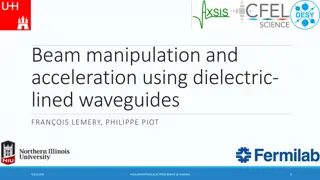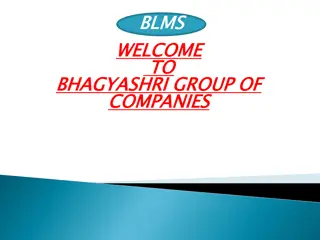Laser-Driven Particle Beams at CLPU: Insights from the RADNEXT 2nd Annual Meeting
Delve into the world of laser-driven particle beams at CLPU as discussed in the RADNEXT 2nd Annual Meeting. Explore topics like high-intensity laser facilities, laser plasma accelerator applications, and the innovative use of Laser VEGA for transnational access. Witness the evolution of laser physics, from Nobel Prize-worthy breakthroughs to the intricacies of laser-driven proton/ion acceleration mechanisms. Discover the fascinating realm of intense laser labs worldwide and the generation of Multi-MeV protons from solid targets through cutting-edge research and experimentation.
Download Presentation

Please find below an Image/Link to download the presentation.
The content on the website is provided AS IS for your information and personal use only. It may not be sold, licensed, or shared on other websites without obtaining consent from the author.If you encounter any issues during the download, it is possible that the publisher has removed the file from their server.
You are allowed to download the files provided on this website for personal or commercial use, subject to the condition that they are used lawfully. All files are the property of their respective owners.
The content on the website is provided AS IS for your information and personal use only. It may not be sold, licensed, or shared on other websites without obtaining consent from the author.
E N D
Presentation Transcript
WP10-TA Laser-driven particle beams at CLPU Jos -Manuel lvarez on behalf of CLPU team RADNEXT 2nd Annual Meeting 9-10 May 2023 https://indico.cern.ch/e/radnext-2023 RADNEXT 2nd Annual Meeting 9-10 May 2023 1
Outline Part 1: Introduction High intensity laser facilities Laser plasma accelerator Applications - Space radiation Part 2: CLPU Laser VEGA Transnational Access WP10 Conclusion RADNEXT 2nd Annual Meeting 9-10 May 2023 2
Intense Laser Labs World Wide Image source International Committee of Ultra-High Intensity Lasers (ICUIL, www.icuil.org) RADNEXT 2nd Annual Meeting 9-10 May 2023 3
Intense Laser Labs World Wide Image source International Committee of Ultra-High Intensity Lasers (ICUIL, www.icuil.org) RADNEXT 2nd Annual Meeting 9-10 May 2023 4
High intensity laser facilities RADNEXT 2nd Annual Meeting 9-10 May 2023 5
High intensity laser facilities Nobel Prize in Physics (2018) to Arthur Ashkin, Donna Strickland and G rard Mourou for ground-breaking inventions in the field of laser physics RADNEXT 2nd Annual Meeting 9-10 May 2023 6
High intensity laser facilities 1020W/cm2 Intensity evolution since the first laser demonstration in 1960, with the different regimes of optics and electrodynamics. RADNEXT 2nd Annual Meeting 9-10 May 2023 7
Laser-driven proton/ion acceleration using TNSA mechanism In the Target Normal Sheath Acceleration (TNSA) mechanism the accelerating electrostatic field is located at the rear target surface of a solid target. RADNEXT 2nd Annual Meeting 9-10 May 2023 8
Multi-MeV protons from solid targets Protons have been observed and characterized in a large number of laboratories and for different laser pulse regimes. Snavely et al, PRL 85 (2000) 2945 Experimental scaling of proton energy cut-off with laser power and pulse duration from Zeil et al. (2010), New J. Phys. 12, 045015. Up to 94MeV protons observed at Vulcan laser, Nat Commun 9, 724 (2018). RADNEXT 2nd Annual Meeting 9-10 May 2023 9
Electrons from solid targets T. Liang et al., 2016 A Maxwellian fit yields a characteristic slope of T=2.1MeV RADNEXT 2nd Annual Meeting 9-10 May 2023 10
Laser Wakefield Acceleration - LWFA Electron acceleration from a gas jet. Image from Rev. in Mut. Res. 704 (1-3), 142, 2010 Data is based on 50+ publications on LWFA during the last 15-20 years from Wenz, J., & Karsch, S. (2020). Physics of Laser-Wakefield Accelerators (LWFA). arXiv: Accelerator Physics. Experimental results for electron peak energy and charge. RADNEXT 2nd Annual Meeting 9-10 May 2023 11
Laser Wakefield Acceleration - LWFA Laser wakefield accelerator is one of the plasma acceleration schemes that underpins the EuPRAXIA project. EuPRAXIA envisions a beam energy of 1 to 5 gigaelectronvolts (GeV) and a beam quality (single pulse) equivalent to present RF-based linacs. Electron acceleration from a gas jet. Image from Rev. in Mut. Res. 704 (1-3), 142, 2010 Data is based on 50+ publications on LWFA during the last 15-20 years from Wenz, J., & Karsch, S. (2020). Physics of Laser-Wakefield Accelerators (LWFA). arXiv: Accelerator Physics. Experimental results for electron peak energy and charge. RADNEXT 2nd Annual Meeting 9-10 May 2023 12
Applications - Space radiation B. Hidding et al, (2013) Van Allen radiation belt Solar flares: photons, charged particles Trapped protons & electrons RADNEXT 2nd Annual Meeting 9-10 May 2023 13
Applications - Space radiation Schimmerling,.W and Curtis, S.B, NASA RADNEXT 2nd Annual Meeting 9-10 May 2023 14
Applications - Space radiation Trapped Particles Environment : Electron S. Samwel et al.,International Journal of Astronomy and Astrophysics 01, 2006. Reproduction of electron fluxes in the GPS orbit with laser-plasma- generated electron flux with T=0.65MeV. Hidding et al. (2013), ESA NPI Activity 4000102854 RADNEXT 2nd Annual Meeting 9-10 May 2023 15
Applications - Space radiation Trapped Particles Environment : Proton S. Samwel et al.,International Journal of Astronomy and Astrophysics 01, (2006). Hidding, B., et al. Laser-plasma-based Space Radiation Reproduction in the Laboratory. Sci Rep 7, 42354 (2017). RADNEXT 2nd Annual Meeting 9-10 May 2023 16
Outline Part 1: Introduction High intensity laser facilities Laser plasma accelerator Applications - Space radiation Part 2: CLPU Laser VEGA Transnational Access WP10/TA2 Conclusion RADNEXT 2nd Annual Meeting 9-10 May 2023 17
Centro de Lseres Pulsados - CLPU CLPU is: a user facility opened to national & international users a ICTS Technical and Scientific unique Infrastructure Radiactive authorized installation IRA-3254 RADNEXT 2nd Annual Meeting 9-10 May 2023 18
Laser VEGA overview Slice from Cruz Mendez VEGA 2 Energy 6 Joules Power 200 TW Rep rate 10 Hz VEGA 3 Energy 30 Joules Power 1 PW Rep rate 1 Hz Target Area close to compressor s output. Laminar flow cabinets with ISO Class 7 level. Metrology bench installed between VEGA 2 and VEGA 3. CEP and ns laser installed at the beginning of 2019 in the laser bay. Uncompressed VEGA 3 output also indicated. RADNEXT 2nd Annual Meeting 9-10 May 2023 19
Array of data given to users from the metrology bench every day: Near field (image at compressor entrance) Far field (lens focal plane 2.1 m focal length) Wizzler temporal measurement (shape and phase) Sequoia temporal contrast measurement Wavefront+Strehl ratio measurement (Phasics) Output spectrum Slice from Cruz Mendez RADNEXT 2nd Annual Meeting 9-10 May 2023 20
Laser VEGA RADNEXT 2nd Annual Meeting 9-10 May 2023 21
Laser VEGA RADNEXT 2nd Annual Meeting 9-10 May 2023 22
Transnational Access WP10/TA2 Offered particle beams: Proton beam Energy 10-20 MeV Charge ~ nC/ps Divergence 0.3-0.4 rad (~ 20 ) Electron beam up to Energy 300-400 MeV Charge ~ pC/fs Divergence 10-20 mrad (~ 1 ) Offered access time 150 hours Number of projects ~ 3 Number of Users ~ 6 Slice from Luca Volpe RADNEXT 2nd Annual Meeting 9-10 May 2023 23
Interaction Chamber VEGA2 Typical non-monoenergetic electron spectrum measured with 1.2 tesla magnetic spectrometer; (in-sertion) ltered image of measured electron energy spectrum RADNEXT 2nd Annual Meeting 9-10 May 2023 24
Interaction Chamber VEGA3 Salgado-L pez, C. et al. Angular-Resolved Thomson Parabola Spectrometer for Laser-Driven Ion Accelerators. Sensors 2022, 22, 3239. https://doi.org/10.3390/s22093239 RADNEXT 2nd Annual Meeting 9-10 May 2023 25
Some requirements on the diagnostic systems The proton/ions accelerated by laser-plasma typically present a broadband spectrum. The complete and accurate characterization of the whole spectrum requires to have a diagnostic system characterized by high sensitivity to appreciate the maximum achievable energy, but also to have a high dynamic range. When a high intensity laser interacts with matter, intense electromagnetic waves (EMP) in the microwave-radiofrequency range are produced. This is a serious threat for any electronic device placed near the interaction point, leading to the disabling, or even to the damaging, of the deployed diagnostic systems. The use of passive detectors generally solves the problem, but this is not a viable solution when aiming for an on-line characterization of a system working at high repetition rates. RADNEXT 2nd Annual Meeting 9-10 May 2023 26
Transnational Access Campaign CLPU has hosted one RADNEXT Campaign TA04-55:Laser-driven Ion Sources for Applications (PI Dimitri Batani) The proton-boron fusion reaction was explored to develop a high brightness laser-driven alpha-particle source Different setup where proposed: (a) Pitcher-catcher configuration: TNSA proton produced from thin aluminium foil target (Pitcher) interact on a solid thick B6Ca or B target (catcher). (b) Directly irradiation of thick samples rich of Boron-nitride (BN) target. The campaign was performed in marz 2023 with VEGA-3. CLPU offered the laser ion-acceleration set up. RADNEXT 2nd Annual Meeting 9-10 May 2023 27
Conclusion During the past twenty years the progresses in laser-driven acceleration mechanisms led to the proposition to use them as an alternative source of energetic particles for many different applications. Laser-driven source might cover the need of affordable and compact accelerators for electronics component irradiation. The generation of particle beams with energy and quality (single pulse) equivalent to conventional accelerator is envisions (EuPRAXIA project). The generation of broadband energy is much easier than the monoenergetic beams, early applications of the high intensity laser facilities for space radiation reproduction are possible. The Spanish Laser Center (CLPU) is a high intensity laser facility with capability to contribute in this field, together with the community. RADNEXT 2nd Annual Meeting 9-10 May 2023 28
Thanks for your attention! RADNEXT 2nd Annual Meeting 9-10 May 2023 29























